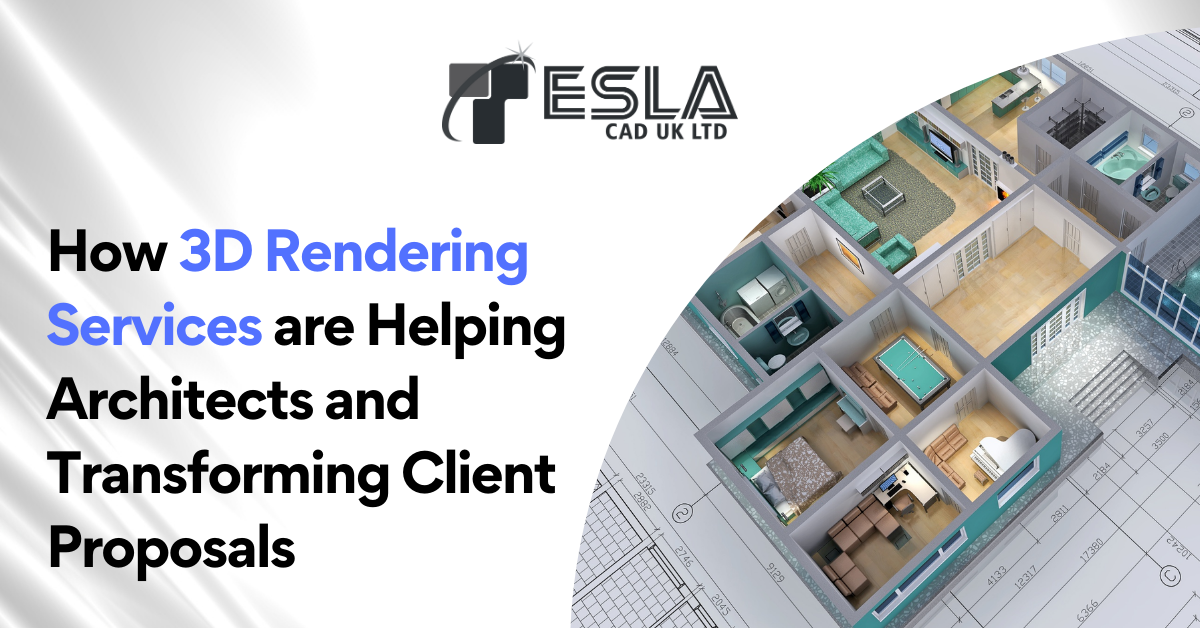How 3D Rendering Services are Helping Architects and Transforming Client Proposals

The arrival of 3D Rendering, also known as architectural visualization, has significantly changed the way architects work and has also impacted how they create, present, and explain their ideas. This has resulted in transforming the client’s proposals into tangible and immersive experiences, allowing clients to step into the future of their space. In this article, we will explore the broad effects of 3D Rendering Services on the architecture industry, focusing on key areas like communicating designs, interacting with clients, and growing businesses. We will examine how 3D Rendering Services has elevated the client proposals.
What are the Effects of 3D Rendering Services on the Architecture Industry?
- Design and Communication
- Revolutionized visualization: 3D renderings have shifted the way architects communicate designs. Gone are the days of relying solely on static 2D drawings. Now, clients can immerse themselves in a virtual representation of the space, leading to better understanding, collaboration, and fewer misinterpretations.
- Enhanced design iteration: Architects can quickly visualize and test design variations within the 3D model, allowing for faster and more informed decision-making. This agility fosters innovation and leads to more refined and optimized designs.
- Accessibility for non-technical stakeholders: Renderings bridge the gap between technical expertise and broader stakeholder involvement. Clients, investors, and the public can easily understand and engage with the design, leading to more inclusive and collaborative design processes.
According to the McKinsey Global Institute, Immersive technologies like 3D rendering will contribute up to $5 trillion to the global economy by 2030.
2. Marketing and Business
- Competitive advantage: High-quality renderings present projects in a captivating and professional manner, setting firms apart from the competition. They attract potential clients by showcasing design capabilities and creating an emotional connection with the proposed space.
- Global reach: Renderings transcend geographical limitations, allowing architects to market their services internationally and to a wider audience. They effectively showcase projects within online portfolios and marketing materials, expanding business reach and opportunities.
- Streamlined sales process: By providing a clear visual representation of the project, renderings can shorten the sales cycle and expedite client decision-making. This translates to increased efficiency and cost-effectiveness for architectural firms.
3. Industry Practices and Technology
- Virtual presentations and collaboration: 3D models facilitate remote collaboration and presentations, especially relevant in a globally interconnected world. Virtual walkthroughs and interactive models enhance communication and decision-making across teams and geographical distances.
- Integration with other technologies: Renderings seamlessly integrate with technologies like virtual reality (VR) and augmented reality (AR), offering even more immersive and interactive experiences. This pushes the boundaries of design exploration and client engagement.
- Standardization and automation: Standardized rendering platforms and tools improve efficiency and accessibility within the industry. Automation of repetitive tasks frees up architect time for more creative and strategic endeavors.
How 3D Rendering Transforms Client Proposals?
- Enhanced Visualization: Clients can gain a clear and realistic understanding of your proposed project without physical prototypes. They can “walk through” spaces, see detailed finishes, and experience different lighting scenarios, leading to better-informed decisions.
- Improved Communication: 3D renderings bridge the gap between technical drawings and abstract descriptions. They provide a common language for both technical and non-technical clients, fostering better collaboration and reducing misunderstandings.
- Increased Appeal: High-quality renderings showcase your creativity and professionalism, making your proposal stand out from the competition. They create an emotional connection with the client, allowing them to envision themselves enjoying the finished project.
- Streamlined Feedback: Clients can easily provide feedback on specific design elements within the 3D model, saving time and money on costly rework later in the project. This iterative process ensures the final design aligns with their vision.
- Reduced Revisions: By allowing clients to virtually experience the design beforehand, there’s a lesser chance of major revisions after project approval. This leads to smoother project execution and increased client satisfaction.
- Enhanced Marketing: 3D renderings can be used in marketing materials to attract new clients and showcase your portfolio. They effectively demonstrate your capabilities and the potential value you offer, leading to increased business opportunities.
Wrapping up…
The introduction of 3D Rendering Services into the architecture field has fundamentally changed how architects work, communicate, and interact with clients. This technology offers distinct advantages beyond just optimizing workflows and saving time. It empowers architects to explore new creative avenues, fuels business growth, and also helps clients to better visualize and understand design concepts, leading to more informed decisions, increased satisfaction, and stronger collaborative relationships. As the architectural industry further embraces technological advancements, 3D rendering’s potential to transform the architectural landscape will not only continue to expand but will offer exciting possibilities for the future.
